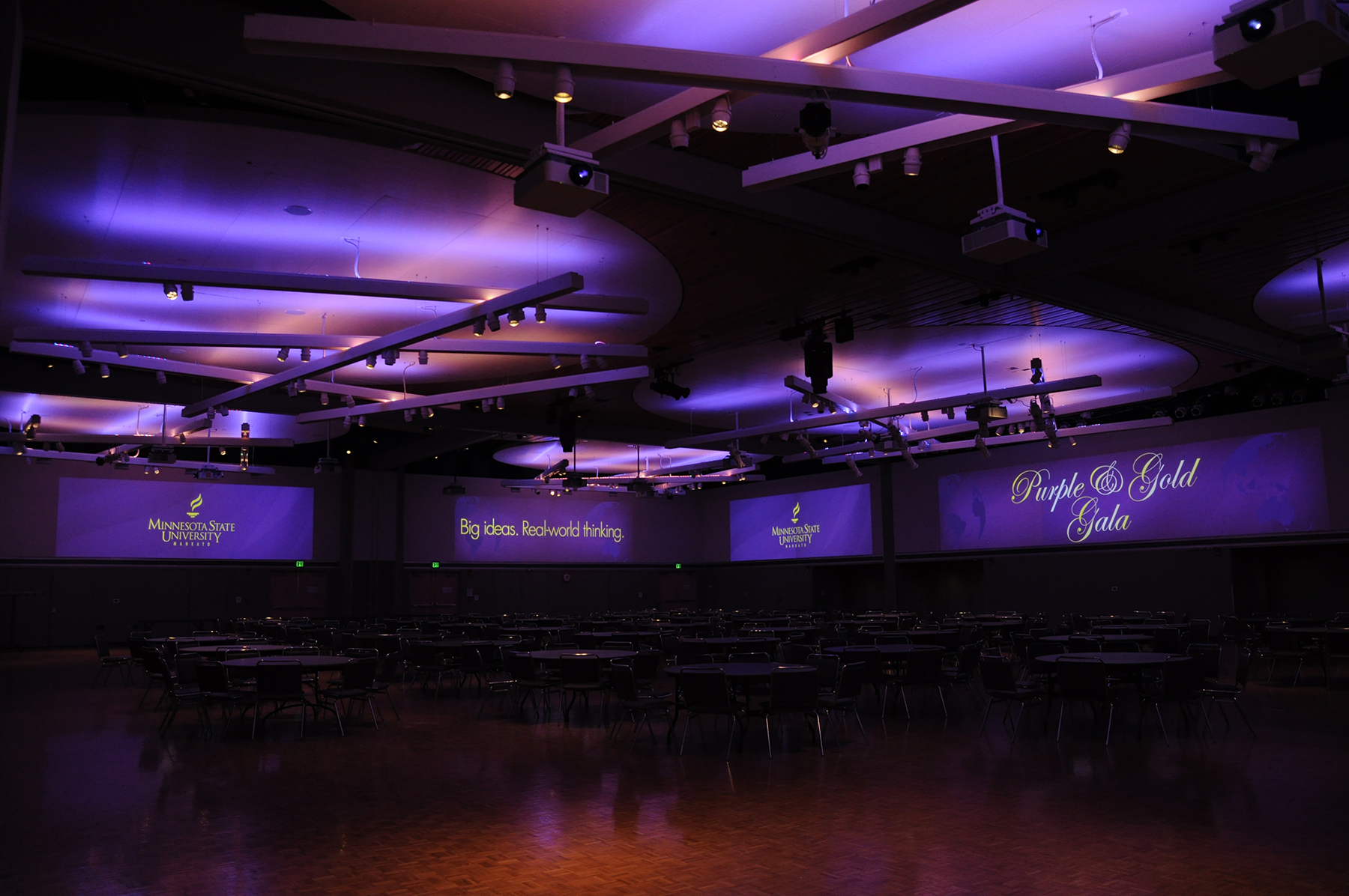Minnesota State University, Mankato’s 10,000-square-foot Centennial Student Union (CSU) Ballroom is a popular space on-campus that serves as a multi-functional public venue used for lectures, conferences, career and community expos, festivals, banquets, and wedding receptions. With the help of integrator EPA Audio Visual, the ballroom recently received a technology upgrade, adding 17 of Sony’s VPL-FHZ90L 9,000 lumen WUXGA laser projectors to provide color-matched projection capabilities around the perimeter of the room.
According to Sony, this installation not only improved the visual experience within the ballroom, but earned the CSU Ballroom the distinction of being the first conference space in Minnesota offering near surround video.
Ryan Strelow, technical services coordinator for the Centennial Student Union at tthe university detailed how the project came together. “EPA Audio Visual went above and beyond to make the technology selection process straightforward and the installation run smoothly. We worked with them to not only identify the best projectors for our vision, but to design, engineer and outfit an enhanced projection system. Our previous equipment was outdated, so we made the decision to upgrade to Sony laser projection because it was the best option to eliminate the issues we had with our former models, while also meeting our needs moving forward,” he said.

Some of those issues were resolved immediately by adopting a laser light source. “Our previous projectors were lamp-based,” Strelow explained.“We realized we were spending thousands of dollars a year replacing the lamps and appreciated that Sony’s laser projectors are twice as bright and virtually maintenance-free for 20,000 hours, saving us time and money. We put a lot of hours on these projectors in a typical week, so it was critical that we chose an efficient product that can keep up with our utilization, with minimal upkeep. The benefit of saving thousands of dollars and hours of work by not having to replace projector lamps has not gone unnoticed.”
Shane King, director of sales and marketing for EPA Audio Visual cited visual impact, vivid colors, picture quality, and reliability as the key differentiators that set Sony’s projectors apart from the competition. He said, “The reality creation video processing and rich color saturation provided by the 3LCD engine provides an experience above any competitor product.” King also noted Minnesota State Mankato’s legacy standardization of Sony projection in the classrooms as a driving force behind the decision to choose the model.
King explained, “The Sony projection system accomplishes the goal of elegantly integrating with the environment to deliver state of the art performance and user-friendly operation that incorporates wireless technology. The addition of the new projectors was timely and achieved the light output and performance requirements necessary to make a considerable impact in this high-profile, heavily-utilized space.”
[The Technology Manager's Guide to Projectors and Screens]
With the Sony laser projectors, the CSU Ballroom takes advantage of the model’s constant brightness, detailed resolution, automated filter system, energy saving features, low noise, and installation flexibility.
One of the distinguishing features that stood out to Strelow is the projector’s ability to project side-by-side and to edge blend to create larger, higher resolution pictures. He described how this benefits the venue: “In our configuration, the projectors can be used as seventeen individual 1920 x 1080 display screens, or side-by-side in groups of two creating six 3840 x 1080 display screens. The projectors at the front of the room can be used as a group of three projectors creating a 5760 x 1080 display screen. The projectors are used as presentation displays for lectures and performers. We also use our multi-display software to organize photos, animations, graphics, video, and live feeds across multiple projected display areas. This true HD imagery is a big step up from the 720p resolution we were getting from our prior projectors.”
Speaking of the unique configuration and challenges the team overcame to create this dynamic environment, King said, “The room was laid out in a way that adjacent projectors needed to align perfectly to provide a seamless immersive experience. Additionally, throw distances ranged very broadly throughout the venue which necessitated four different lens variations to achieve the desired image sizing. The extensive multi-protection white balance and color correction parameters helped optimize the images and Sony’s technical team was instrumental in dialing in consistent imagery throughout the seventeen projectors.”
Another deciding factor that put Sony’s projectors at the top of Strelow’s list was the projector’s color capabilities. “From our previous experience with Sony projectors, we knew that the image quality would be great," he said. "The ability to color match, along with built-in features for color correction and image alignment were attractive features as we looked to create larger screens using side-by-side projection. When compared to other projectors, Sony’s projectors stood out because of the built-in calibration tools that are available to the end users, which are easy to activate and do not require an integrator or certified technician to access.”
In the end, how does this translate to a better experience for CSU Ballroom guests? Strelow concluded, “The most noticeable benefit for the average user of the space is a clearer, crisper, and brighter image on the screens. We no longer receive complaints about text being illegible during presentations. Additionally, the way projection is used in this space is one of the signature elements of the room. While not a lot can always be done as far as decoration goes in our ballroom, the projection capabilities allow us to brand the room for the experience taking place. The enhanced quality of the Sony laser projectors has taken this experience to the next level.”